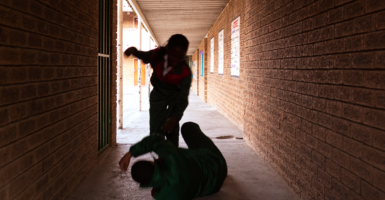As record numbers of fistfights are erupting amid a behavior crisis in the American public education system, more schools are attempting to use restorative justice—even though that process often makes behavioral problems worse.
Restorative justice is a remediation theory that suggests students respond better to affirmation-based conversations in which an adult de-escalates any problem situation by calmly discussing the students’ feelings about the problem until everyone agrees.
Restorative justice relies on student investment and commitment to say, “I am willing to do this.”
Traditional methods of discipline are seen as utterly barbaric, with fans of restorative justice suggesting that punishing a student for violent or other bad actions sets them on an unshakable path toward prison and abuse.
Proponents often point to schools that adopted the practice of restorative justice and saw a sharp decline in suspensions—Oakland Unified School District in California, for example. Although suspensions in Oakland Unified have decreased, the level of violence and total number of police incidents in the school district have not.
Few, if any, schools that have adopted restorative justice as a replacement for traditional discipline have seen a healthier school environment that is safer for teachers and students.
Unfortunately for those who seek the utopian, unicorn sunshine of these practices, the majority of students don’t respond well to restorative justice. Hundreds of public school districts that use it are experiencing large numbers of physical fights and continual chaos that is more responsible for driving teachers out of the classroom than almost any other issue.
Restorative justice fails thousands of classrooms a day in situations such as this recent one in Wisconsin described by Milwaukee English teacher Daniel Buck:
A student gets into a violent fight in the classroom—students’ safety is threatened, and the teacher struggles to break up the fight before calling the office. The office may (or may not) send an administrator, counselor, or other office-staff member to the classroom, where the fighting students are taken into the hallway or the office for a brief discussion about their actions.
Most often, the students are told to get along, sent back to class, and within five minutes nothing more has occurred than putting the safety of students at risk with both violent students back in their seats with no more than a polite ‘talking to.’ These students don’t buy into restorative practices. Why should they care?
Any adult who has spoken with a child after (or during) a fight knows that rational dialogue and feelings-centric relationship-building aren’t at the forefront of his mind. Why would a violent or disruptive student choose to engage in an “opportunity for equitable dialogue and participatory decision-making” when he can simply mumble at the floor and be sent from the office back to class without punishment regardless?
I have yet to see a single pair of high school students who just smashed each other’s faces into lockers and cement walls genuinely respond with an air of reconciliation to the questions, “What can you do to repair the harm?” or “Who else was affected by what you did?”
You’re far more likely to hear a screaming explanation of why the other student “needed his a– beat.”
At some point, we must consider what we’ve given up to gain far too little.
American classrooms have given up detentions, suspensions, and community service as methods of delivering justice in order to gain a never-ending cycle of violence; this teaches students that they may do whatever they wish with no observable risk.
We also forget the additional impact that this horrific policy has on innocent students and teachers who are just trying to engage in the learning process.
How are students supposed to focus on their education when desks are thrown aside by students who are pulling each other’s hair and screaming at the top of their lungs? How are teachers supposed to teach when students are throwing each other across the room without respite?
As the science and STEM coordinator for Indianapolis Public Schools, I watched my science teachers struggle under the weight of a failed system as their students beat each other to the point of senselessness day after day, without any administrative action other than “sharing their feelings.”
The National Education Association, the nation’s largest teachers union, continues to preach that the “school-to-prison pipeline” is solved by restorative justice. But it seems that students are more likely to be thrown in prison as a result of the practice.
Students who are violent and disruptive without consequences one day will find that police departments don’t have restorative conversation circles. Crimes will be met with prison sentences.
As a teacher, I was told repeatedly in our “equity meetings” that the classical methods of justice were harmful and ineffective—yet charter and private schools that still practice these methods enjoy the privileges of safe hallways and classrooms, fewer police incidents, and a better environment for learning.
Restorative justice practices have driven many teachers I’ve spoken with to tears. Entire schools have locked their bathrooms during the day to prevent students from killing each other between classes. Instagram accounts celebrating hourly fights in large public schools spring up so often that social media platforms have trouble taking them down.
The Justice Department announced March 6 that it would offer grants to teach university education departments about the supposed virtues of restorative justice, hoping to “educate, train, and build knowledge on restorative justice approaches, principles, and their application to criminal justice and community safety.”
Despite the record of classical discipline and justice in creating safe environments, despite the numerous examples we have of these methods working effectively, the Biden administration seems bent on pushing us ever close to the false dream of utopia. And our children will pay the price.
Have an opinion about this article? To sound off, please email letters@DailySignal.com and we’ll consider publishing your edited remarks in our regular “We Hear You” feature. Remember to include the url or headline of the article plus your name and town and/or state.

























